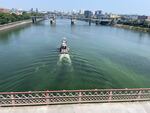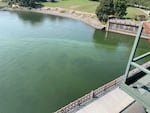
A tug motors through the algae bloom in the Willamette River as it passes through downtown Portland. Aug. 16, 2023.
Courtesy Willie Levenson/Human Access Project
The algae bloom in the Willamette River as it passes through downtown Portland continues to make the water hazardous for recreational use, and state health experts say we need cooler temperatures and possibly rain to resolve the problem.
Algae is one of the earliest forms of life and harmful blooms have been occurring for millennia. They’re fueled by naturally occurring nutrients, like decaying vegetation and by human activity. The Oregon Health Authority says climate change is also likely increasing the frequency and duration of blooms.
Oregonians were warned Monday not to swim along certain stretches of the Willamette River because of an algae bloom stretching from the Ross Island Lagoon to Cathedral Park. It’s not clear when that warning will be lifted.
“The temperature is projected to decrease over the next few days. So hopefully we’ll see a reduction before too long,” said Jen Seamans, manager of the Oregon Health Authority’s Environmental Public Health Surveillance Program. “Once it rains, the increased water flow will help reduce the blooms.”
Large toxic algae blooms have been occurring along the Willamette River near downtown Portland since 2015. Seamans said authorities weren’t surprised by this week’s bloom. But they were surprised by the rate at which it expanded.
“It was unprecedented,” Seamans said.
Clark County Public Health issued an algae advisory Thursday at Vancouver Lake. Another advisory remains in place at Lacamas Lake in Washington.
The OHA has nine algae advisories around the state, including Cullaby Lake in Clatsop County and Galesville Reservoir in Douglas County.
Oregon has no ongoing algae monitoring system. Funds haven’t been earmarked for such a system. But when blooms are observed or expected, authorities test the water and release the results.
Algae testing is not cheap .But Oregon State University just announced that researchers have developed a new way to monitor harmful algae blooms by “sniffing” water for gases associated with toxins.
Many of Oregon’s rivers and lakes are safe for swimming. But the OHA recommends not swimming in water that looks foamy, scummy, thick like paint, pea-green, blue-green or brownish red. A good rule of thumb is: If in doubt, stay out.
In 2017, more than 30 cattle died after drinking contaminated water at Junipers Reservoir near Lakeview during an algae outbreak.

Harmful algae bloom along the Willamette River in downtown Portland, Aug. 16, 2023
Courtesy Willie Levenson/Human Access Project
The Oregon Health Authority says symptoms from algae poisoning include headaches, cramps, diarrhea, vomiting, numbness, dizziness and fever. Children and pets are at increased risk of exposure because of their size and level of activity. Symptoms generally begin within 24 hours and last 72 hours.

